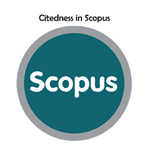Analisis Potensi Farmakokinetik dan Toksisitas Pada Curcumin (Curcuma xanthorrhiza) Sebagai Brightening Terhadap Reseptor Protein Tirosinase Secara in Silico
Abstract
Full Text:
PDFReferences
R. Pushpalatha, S. Selvamuthukumar, and ..., "Comparative insilico docking analysis of curcumin and resveratrol on breast cancer proteins and their synergistic effect on MCF-7 cell line" J. Young "¦, 2017.
R. Mustarichie and D. Ramdhani, "In-silico study of compounds of Curcuma xanthorriza against enzyme tyrosinase sac and α-MSH" Asian J. Pharm. Res. "¦, 2022.
A. R. Blaustein and C. Searle, "Ultraviolet Radiation" Encycl. Biodivers. Second Ed., no. May, pp. 296-303, 2013, doi: 10.1016/B978-0-12-384719-5.00147-7.
A. Parthiban, R. Sivasankar, B. Rajdev, R. N. Asha, and ..., "Synthesis, in vitro, in silico and DFT studies of indole curcumin derivatives as potential anticancer agents" J. Mol. "¦, 2022.
A. Haerani, A. Chaerunisa, Yohana, and A. Subarnas, "Artikel Tinjauan: Antioksidan Untuk Kulit" Farmaka Univ. Padjadjaran Bdg., vol. 16, no. 2, pp. 135-151, 2018.
A. Prasetiyo, E. Mumpuni, and R. R. Tjandrawinata, "Docking Molekular dari Trigonella foenum-graceum sebagai Antidiabetes menggunakan Molegro Virtual Docking" J. Jamu Indones., vol. 4, no. 2, pp. 74-80, 2019, doi: 10.29244/jji.v4i2.132.
D. Krihariyani et al., "Studi Insilico Aktivitas Antioksidan dan ADMET Brazilein Kayu Secang (Caesalpinia sappan L.) terhadap Escherichia Coli Extended Spectrum Beta-Lactamase (ESBL) (Kandidat Suplemen Penguat Sistem Imun)" Pros. Semin. Nas. Kesehat., pp. 251-257, 2019.
S. Hardjono, "Prediksi Sifat Farmakokinetik, Toksisitas dan Aktivitas Sitotoksik Turunan N-Benzoil-N'-(4-fluorofenil)tiourea sebagai Calon Obat Antikanker melalui Pemodelan Molekul" J. Ilmu Kefarmasian Indones., vol. 14, no. 2, pp. 246-255, 2017.
R. Mazieiro, R. R. Frizon, S. M. Barbalho, and ..., "Is curcumin a possibility to treat inflammatory bowel diseases?" J. Med. "¦, 2018, doi: 10.1089/jmf.2017.0146.
V. T. Nguyen, T. M. Huynh, T. N. Q. Nguyen, and T. H. Le, "Enhancing the stability of synthesized curcumin by spray-drying microencapsulation with soy lecithin and gum Arabic" Braz. J. "¦, 2021, doi: 10.1007/s43153-021-00124-3.
K. Girish, B. C. Channu, and A. R. Baba, "Synthesis and antibacterial activity of cobalt (II) complex of curcumin" "¦ J. Pharm. Sci., 2019.
Z. Kocer, B. Aru, U. A. Sezer, G. Y. Demirel, and ..., "Process optimisation, biocompatibility and anti-cancer efficacy of curcumin loaded gelatine microparticles cross-linked with dialdeyhde carboxymethyl cellulose" J. "¦, 2019, doi: 10.1080/02652048.2019.1646337.
A. R. Puspaningtyas, "Molekular Docking Dengan Metode Molegro Virtual Docker Turunan Kalkon Sebagai Antimikroba" Stomatognatic, vol. 9, no. c, pp. 39-47, 2012.
U. P. Ningsih and R. Novianty, "STUDI IN SILICO SENYAWA ARECOLINE (Areca cathecu L.) SEBAGAI KANDIDAT OBAT ANTIDEPRESAN" vol. 02, no. 02, pp. 493-496, 2018.
D. E. V. Pires, T. L. Blundell, and D. B. Ascher, "pkCSM: Predicting small-molecule pharmacokinetic and toxicity properties using graph-based signatures" J. Med. Chem., vol. 58, no. 9, pp. 4066-4072, 2015, doi: 10.1021/acs.jmedchem.5b00104.
DOI: https://doi.org/10.37311/ijpe.v3i2.18878
Refbacks
- There are currently no refbacks.
Copyright (c) Anjas - wilapangga

Indonesian Journal of Pharmaceutical Education is licensed under a Creative Commons Attribution-NonCommercial-ShareAlike 4.0 International License.



